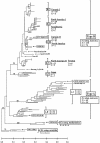Worldwide genetic relationships among Francisella tularensis isolates determined by multiple-locus variable-number tandem repeat analysis
- PMID: 15317786
- PMCID: PMC516809
- DOI: 10.1128/JB.186.17.5808-5818.2004
Worldwide genetic relationships among Francisella tularensis isolates determined by multiple-locus variable-number tandem repeat analysis
Abstract
The intracellular bacterium Francisella tularensis is the causative agent of tularemia and poses a serious threat as an agent of bioterrorism. We have developed a highly effective molecular subtyping system from 25 variable-number tandem repeat (VNTR) loci. In our study, multiple-locus VNTR analysis (MLVA) was used to analyze genetic relationships and potential population structure within a global collection of 192 F. tularensis isolates, including representatives from each of the four subspecies. The VNTR loci displayed between 2 and 31 alleles with Nei's diversity values between 0.05 and 0.95. Neighbor-joining cluster analysis of VNTR data revealed 120 genotypes among the 192 F. tularensis isolates, including accurate subspecies identification. F. tularensis subsp. tularensis (type A) isolates showed great diversity at VNTR loci, while F. tularensis subsp. holarctica (type B) isolates showed much lower levels despite a much broader geographical prevalence. The resolution of two distinct clades within F. tularensis subsp. tularensis (designated A.I and A.II) revealed a previously unrecognized genetic division within this highly virulent subspecies. F. tularensis subsp. holarctica appears to have recently spread globally across continents from a single origin, while F. tularensis subsp. tularensis has a long and complex evolutionary history almost exclusively in North America. The sole non-North American type A isolates (Slovakian) were closely related to the SCHU S4 strain. Significant linkage disequilibrium was detected among VNTR loci of F. tularensis consistent with a clonal population structure. Overall, this work greatly augments the study of tularemia ecology and epidemiology, while providing a framework for future forensic analysis of F. tularensis isolates.
Figures




References
-
- Agapow, P. M., and A. Burt. 2001. Indices of multilocus linkage disequilibrium. Mol. Ecol. Notes. 1:101-102.
-
- Broekhuijsen, M., P. Larsson, A. Johansson, M. Byström, U. Eriksson, E. Larsson, R. G. Prior, A. Sjöstedt, R. W. Titball, and M. Forsman. 2003. Genome-wide DNA microarray analysis of Francisella tularensis strains demonstrates extensive genetic conservation within the species but identifies regions that are unique to the highly virulent F. tularensis subsp. tularensis. J. Clin. Microbiol. 41:2924-2931. - PMC - PubMed
-
- Burke, D. S. 1977. Immunization against tularemia: analysis of the effectiveness of live Francisella tularensis vaccine in prevention of laboratory-acquired tularemia. J. Infect. Dis. 135:55-60. - PubMed
Publication types
MeSH terms
Substances
Associated data
- Actions
- Actions
- Actions
- Actions
- Actions
- Actions
- Actions
- Actions
- Actions
- Actions
- Actions
LinkOut - more resources
Full Text Sources
Other Literature Sources
Molecular Biology Databases

